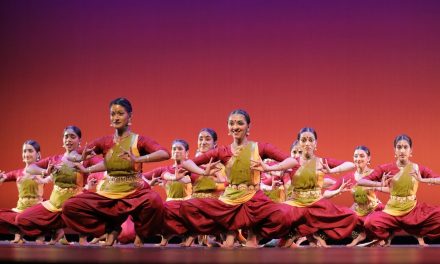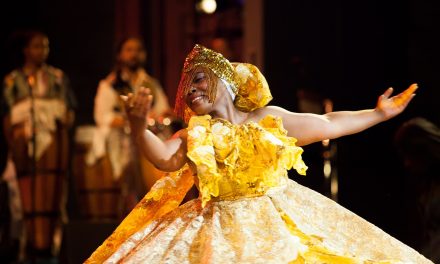For those of you who were not in attendance at the Théâtre Raymond Kabbaz on Friday, October 26, 2018 for the performance of Hélène Blackburn’s 9, you missed an extraordinary performance presented by Cas Public & Kopergietery. The work was beautiful, thought provoking, tender, extraordinarily complex, rapid fire, and with a dash of humor. The work was performed by five dancers who executed Blackburn’s very intricate movement with the ease of slipping on a pair of shoes, but with the excitement that is rarely matched. I did not see a single misstep, falter or miscue from the performers or the lighting crew. This performance was astonishing, and the dancing was sublime.
Founded in 1989, Cas Public is based in Quebec, Canada. Blackburn states that she views creation as a collective art and that 9 was created in collaboration with the dancers. It was inspired by dancer Cai Glover overcame a hearing impediment to become a professional dancer at the age of 18. And can he dance! In a post-performance Q&A, Glover stated that Blackburn was the first company artistic Director who, instead of trying to hide his hearing aids, embraced his impairment and the unique way which it caused him to interpret music.
Blackburn had her cast of performers learn to sign the text of a piece of music and other specific words. She took that and turned sign language, ballet and contemporary dance into something just short of magical. Hands, fingers, arms, faces and audible sounds became a movement vocabulary to enable these beautiful dancers to partner with each other in ways that were not only interesting, but sped by like lighting.
As we entered the intimate Théâtre Raymond Kabbaz, the stage was filled with white chairs of many different sizes, but the largest no bigger than a kindergarten school chair. Two young boys sat in chairs while the grown ups attempted to balance smaller chairs on their heads. As the piece began, they were joined by a very young girl and another grown woman who joined in a game of stealing seats from each other. All this changed when a film appeared on a back screen hanging upstage, of a young boy smiling into the camera and removing his hearing aids.
9 was about differences that come together to make everything better rather than to separate. It was a work that we needed to see at this time in our history as a nation. Blackburn’s work did not preach, it did not shout, but as it progressed we noticed how the different sizes of chairs worked together with Blackburn’s imagination to create multiple environments of multiple shapes and diameters. Sign language, which is a different form of communication than what many consider “normal” became a beautiful instrument of bringing people together to communicate in yet another way. The three children were integrated into the work without making them feel out of place, and a remote-controlled white car become a vehicle of humor as well as a member of the cast.
The film by Kenneth Michiels expresses how the world of someone with a hearing problem can be closed off, but how with the aid of science, that can change. Here too, however, Michiels embraces the child’s world and we see him eventually join his friends in their world of unity and sameness. At the end of the film, he is not treated as different, but one with the others; an equal.
Blackburn’s 9 was also a work of contrasts. The dancers were costumed in gray pants and shirts. The chairs were white, and the lighting was stark, and mostly white specials, which gave the piece the feeling of a film noir. Emilie B-Beaulieu and Hélène Blackburn’s lighting design shifted as rapidly as the choreography, and just like the dancing, there was never an obvious miscue.
It would not do the work justice for me to use words to describe the movement. Ballet fused with sign language and contemporary dance are words that only weaken what Blackburn has created. Just imagine dancers incorporating arm gestures as they intertwine their arms and legs at a speed that seems impossible. Imagine ballet port de bras (carriage of the arms) united with sign language vocabulary that almost became understandable as conversations to someone who does not understand sign language.
Blackburn incorporates a great deal of repetition of movements, sometimes driving the performers to the edge of exhaustion. She stops way short of boredom, however. If there was one thing to criticize Blackburn for, and this was strictly a personal observation, it was that I began to feel fatigued by the constant barrage of movement, and a movement for every beat of the music. Having said that, I was in awe of the precision of the dancers who never missed a partner’s hand or leg, or who never once collided with one of the constantly moving chairs. When Daphnée Laurendeau performed very fast battement tendues, beats and other footwork center stage, her colleagues were placing tiny chairs in her way. Laurendeau never once kicked the miniature chairs over.
This precision never became mechanical or robotic. The dancers kept their humanity. I was exhausted at the end of 9 but also exhilarated, inspired and in awe of the talent that appeared onstage. I hope that this company returns to Los Angeles for a much longer run. See the trailer of 9 below.
The exquisite dancers included Alexander Ellison, Cai Glover, Robert Guy, Daphnée Laurendeau, and Danny Morisette. The three children who gave a wonderful performance were: Theo Cariou, Annouk Parreira, Leo Petauton; all students of Le Lycée Français de Los Angeles. The collage of driving music was by Martin Tetreault; Scenography was by Hélène Blackburn; Costumes were by Michael Slack and Hélène Blackburn; and Dramaturgy was by Johan De Smet.
For information about Cas Public and Kopergietery, click here.
For information about Théâtre Raymond Kabbaz, click here.
Featured image: Cas Public & Kopergietery in “9” – Photo by Damian Siqueiros








